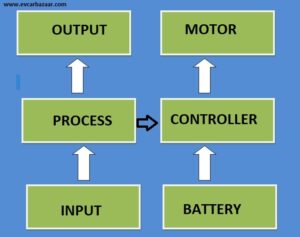Components of Electric Vehicle (EV) 7
When the electric vehicle is running on the road, the battery is supplying the electrical energy i.e. input level is battery. when battery is supplying the electrical energy, we need to control that electrical energy so that we can control the speed of motor, Overall we can control the speed of our vehicle. And this whole process is turned with the help of controller. This controller providing the electrical energy to electrical motor. As a result our vehicles run on the road. So,main components of electric vehicle are: 1.Battery 2.Controller 3.Electric Motor

on the road, the battery is supplying the electrical energy i.e. input level is
battery. when battery is supplying the electrical energy, we need to control
that electrical energy so that we can control the speed of motor, Overall we
can control the speed of our vehicle.
Let’s discuss about these components:
1. Battery Components of Electric Vehicle (EV) 7 When we are taking in context of the electric vehicle, the battery which is used for traction purpose is also known as traction battery. It is the secondary type of battery that means this battery is rechargeable and if we are comparing it with IC engines just replaced the fuel tank by battery pack. Battery stores the electrical energy and provides it when it is needed. 2. Control unit It is also known as EV control unit. This unit controls the vehicle dynamics based on the information from various ev components like Invertor, Battery Management Unit(BMU) and many more things. AS the name suggests, it is a unit, it is not made up of any single component so which component make this unit and these components are Inverters, DC-DC Converters and vehicle control unit.Let us discuss them one by one: 2.1 Inverters Why Inverters is required? We are using our battery to give the supply to our motor but the output of every battery is DC and the supply which our motor requires is AC so we need to convert that DC into AC and inverter does this job very well. If your inverter is of bi-directional category, its functions are doubled. This is not only converting your DC into AC but it is also converting the AC into DC when it comes to regenerative braking. 2.2 DC - DC Converters We are using our battery to supply the motor and run our vehicle. But the battery is not only mean to supply the motor but we have other auxiliaries as well our Speed Controller, Fuel Controller many other controller displays light and many more things which are electronic devices and they works on the level of 12 volt and the output of our battery is quite higher than this 12 volt level so we required low voltage DC-DC Converter which convert this high voltage battery output to 12 volt limit so that we can supply it to our auxiliaries. 2.3 Vehicle control unit (VCU) It is the administrative unit because it administers the operations and distribution of power at any given moment. How it works: It has micro controller which can change the current level or which indirectly affect the working mechanism and this Vehicle Control Unit is mainly used for other to increase the mechanical performance of your vehicle to suit the operator's driving style. Inverters, Converters and Control Unit these are the components of overall control unit or we can say ECU. other components of EV are: Charger Charger is a charging element which gets the electrical energy from external sources such as grid or solar plants or any sources other things and it provides the energy to our battery the energy which we are getting from the outer source is in the form of AC and this AC is converted to DC and then it is fed to our battery to store the energy. We have two types of charger 1.On Board Chargers 2.Off Board Chargers On Board Chargers: These chargers are already installed in Electric vehicle. Off Board Chargers: These chargers are not already installed in Electric vehicles.
3.Electric Motor Components of Electric Vehicle (EV) 7 This is a device which converts electrical energy into mechanical energy. This mechanical energy in the form of rotational motion and majority of cases and if you compare it with the IC engine vehicles just replace the IC engine with electric motors. Electric motors keeps the quite and comfortable operation compared to conventional vehicles. Electric Motors are less noisy and are having less vibration compared to IC engines.



This article contains a lot of valuable info. I am amazed by the quality of the info and also it is a beneficial article for us, Thanks for share it.Car Charging Infrastructure
Casinos Near Me – Dr.MCD
Casinos Near Me · Casinos in Minnesota 경상북도 출장마사지 · Casinos near me 화성 출장샵 · Hotels near me · Casino near me · Gaming 안산 출장샵 near me · 안동 출장마사지 Near me 수원 출장샵 · Casino Near Me.
Get a $200 Bonus at Harrah's Casino in Las Vegas
The wooricasinos.info new Harrah's Casino is one of febcasino.com the most well-known ventureberg.com/ Las Vegas-style casino resorts. It features a full-service aprcasino spa, a full-service spa and
This post is so helpful and significant to expand our insight. I'm glad that you have imparted extraordinary data to us. Thankful to you for sharing an article like this.Car Parts Shop